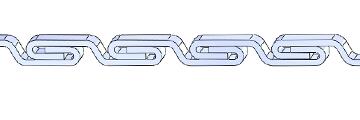8 Ways to Combat Torque in Interlocked Metal Hose
By: Erik Kane
Let’s investigate torque in interlocked hoses.
Interlocked hoses are an excellent choice for industrial applications. Whether it’s used for transferring dry bulk materials, as a robust outer guard for protection of hoses, cables, etc., or as an interior hose liner for resistance against abrasion, interlocked hose has maintained a niche in industry for a long time. And while there are plenty of variables that go into making a good, balanced interlocked hose; the construction of these products has largely remained consistent throughout history. Because of this, the ways they fail have remained consistent as well.
An interlocked hose is made from a single strip of material that is profiled and wound over upon itself to form a helical tube. This shape gives the hose excellent tensile strength, and even better hoop/crush strength depending on how thick the parent strip is. Despite its strength in these areas, interlocked hose is vulnerable to mishandling, which may lead to failure more quickly than a hose under normal service conditions. When it comes to maximizing hose life and ensuring proper service from an interlocked hose, you really want to be on the watch for the number one killer of interlocked hoses: torque.
Because interlocked hoses are a continuous length that consists of one long strip of material throughout the entire hose, when a standard interlocked metal hose is torqued, the entire hose is affected by it. The twisting action causes the hose O.D. (outside diameter) to expand as the strip is pushed back onto itself until eventually the hose will become “un-locked” and fall apart like a spring. This is the most common kind of torqueing that happens with interlocked hoses. While it is possible to torque the hose in the opposite direction and cause it to shrink, natural resilience in the metal makes it “want” to turn back into a flat metal strip. This makes the “un-raveling” O.D. torqueing more common.
It’s important to note that a little bit of torque is not going to destroy a hose overnight, but it has an effect on all performance aspects of the hose. Changing the size of the hose by torqueing it open changes interior flow dynamics because the area inside the hose is larger, affects the flexibility by allowing gaps to form around the overlapping legs of the profile, and creates entrapment zones where product can become stuck or more readily escape out of the hose. A small amount of torqueing can even be completely reversible if the hose is twisted back to where it’s designed to be, but knowing how much torque has been imparted on an interlocked hose can be a difficult thing to determine. Below is a list of 8 ways that you can prevent, monitor, and combat torque in interlocked metal hoses:
- Always uncoil the hose properly. If it is coiled, roll it like a tire until it’s flat. Grabbing one end of the hose and walking with it will cause the entire length to twist.
- When installing a hose for service, refrain from using fitting arms or tools to maneuver the hose into position. If an installation is especially tricky, using swivels on the ends of the hose can help prevent any unwanted twisting during installation.
- Accessories such as hose slings and hose saddles can be used to help alleviate additional unwanted torqueing from handling and service.
- A simple way to keep track of torque is to use painted “lay lines” or “flow-arrows” on the outside of the hose. A lay line is a painted stripe that runs the entire length of the hose, and gives a quick visual indication of how much it’s been twisted (the barber pole effect). The manufacturer can provide this on request.
- Perform simple regular tests of the hose to monitor how much it’s been torqued: with the hose lying flat on the ground, pick up and bend one end until it reaches ninety degrees; if you let go and the hose flops to the ground, it’s probably over-torqued.
- A second simple test can be performed by measuring the I.D. or O.D. of the hose, if you find that it’s more than a half an inch larger than its designed size it’s getting close to coming unlocked.
- If torque becomes a recurring killer of your interlocked hoses, there are alternative constructions available that can combat torque. Knurling the strip to provide a bite between the layers of the interlocking profile prevents torque and helps maintain hose integrity.
- Ultimately, there are shaped variations of interlocked metal hoses with a polygonal cross section that make it next to impossible to torque the hose due to their geometric shape.
Issues with torque can be a challenge, and can sometimes seem unavoidable. Using these tips to your advantage is a great start to maximizing your hose life and fighting the problems associated with torque, but sometimes it takes a little bit extra to solve application problems. For additional information, *click here* to access Hose Master’s stripwound metal hose catalog. Call the inside sales team at Hose Master at 216-481-2020 or e-mail us at insidesales@hosemaster.com and we would be happy to address your needs.

Copyright 2017, Hose Master, LLC
All Rights Reserved
-
When to Use Flexible Metal Products
-
Select the Right Hose for Your Application
-
Select the Right Corrugated Metal Hose
-
Select the Right Stripwound Metal Hose
